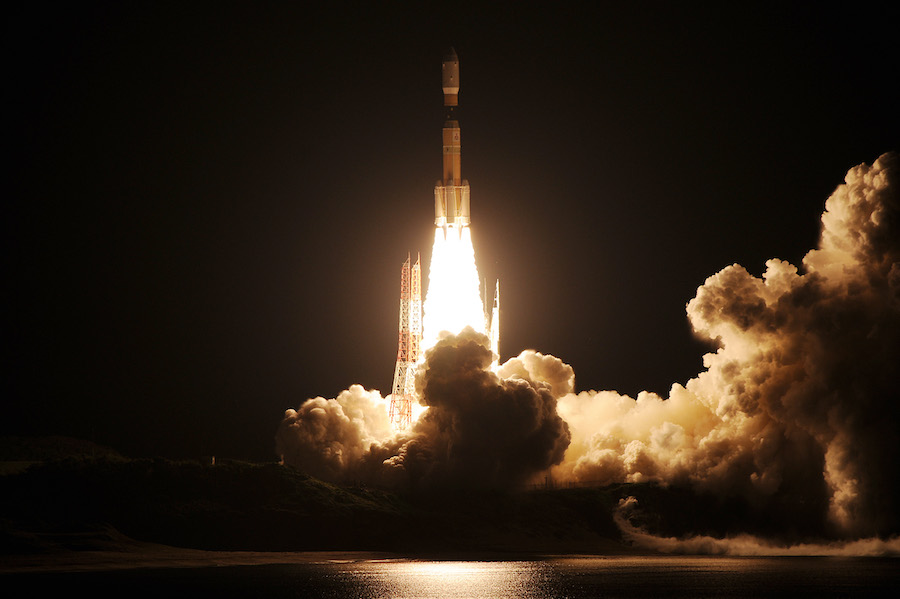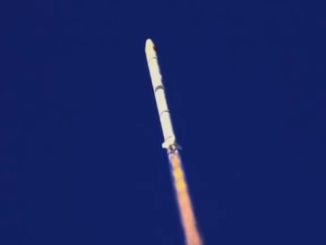
The ninth and final flight of Japan’s H-2B rocket — the country’s most powerful launcher — drove an automated cargo freighter into orbit Wednesday on a five-day pursuit of the International Space Station.
The 186-foot-tall (56.6-meter) launcher lifted off from the Tanegashima Space Center in southern Japan at 1731 GMT (1:31 p.m. EDT) Wednesday, sending an HTV supply ship into space with 2.5 million pounds of thrust from four solid rocket boosters and two hydrogen-fueled core engines.
Wednesday’s launch was the last in a series of nine H-2B rockets, and also marked the ninth and final flight of Japan’s current-generation barrel-shaped HTV cargo carriers. Japan is developing a more capable supply freighter named the HTV-X, which will deliver heavier payloads to the space station.
The HTV-X is scheduled for its first flight to the space station in 2022, and it’s designed to eventually fly supplies to the planned Gateway mini-space station in orbit around the moon.
The H-2B and the less powerful H-2A rocket will be replaced by a new, less expensive Japanese launcher named the H3, which will launch the HTV-X missions. MHI and the Japan Aerospace Exploration Agency, or JAXA, are jointly developing the H3 rocket, which could be ready for an inaugural test flight before the end of 2020.
JAXA provides resupply services to the space station to help pay for Japan’s share of the the research lab’s operating costs.
The HTV spacecraft is nicknamed Kounotori, which is Japanese for “white stork,” and stretches around 33 feet (10 meters) long and 14 feet (4.4 meters) wide. The ninth HTV mission, or Kounotori 9, is packed with more than 13,600 pounds, or 6.2 metric tons, of cargo, supplies and experiments in its pressurized module and on its external payload bay, according to JAXA.
The unpressurized cargo consists of the six new lithium-ion batteries stowed on a pallet inside the HTV’s external payload compartment.
The Japanese freighter will also deliver hardware for government, university and commercial experiments.
One of the payloads packed inside the ninth HTV mission is a module to support a Japanese combustion experiment. The investigation will “scientifically determine the role of gravity in different modes of combustion, such as ignition of solid materials and spreading of flames on various solid materials in the ISS’s environment,” JAXA said on its website.
The HTV is also carrying a camera designed by a Spanish company named Satlantis, which aims to demonstrate the performance of the imaging unit on a platform outside the space station’s Kibo laboratory. Similar cameras could become a standard for future Earth-imaging CubeSats and microsatellites, according to Satlantis.

Japan’s space agency is also delivering new science racks for to the space station NASA and the European Space Agency, plus a water tank and fresh food for the research lab’s crew.
Controlled by station commander Chris Cassidy, Canadian-built robotic arm will capture the Japanese cargo freighter around 1215 GMT (8:15 a.m. EDT) Monday, two days before the launch of a SpaceX Crew Dragon spacecraft from the Kennedy Space Center in Florida on the first crewed orbital flight from U.S. soil since the retirement of the space shuttle in 2011.
Assuming it launches May 27, the Crew Dragon is scheduled to dock with the space station May 28.
The arrivals of the HTV and Crew Dragon in quick succession will make for a busy few days on the space station, which is operating with a limited crew of three, and just one NASA astronaut responsible for the U.S. segment of the orbiting outpost.
Astronauts Doug Hurley and Bob Behnken will fly to the space station on the Demo-2 flight. Their stay at the station could last one-to-four months
Hurley and Behnken will assist Cassidy — the sole NASA crew member currently on the station — with experiments and spacewalks. Behnken and Cassidy are slated to perform several spacewalks as early as June to install the lithium-ion batteries to be delivered by the HTV mission.
Inside the station, Hurley will operate the research lab’s robotic arm to move Cassidy and Behnken around during the spacewalks. The batteries on the ninth HTV flight will be installed on the space station’s outboard S6 segment on the far starboard side of the craft’s 356-foot-long (108.5-meter) truss structure.
Once the battery spacewalks are complete, old nickel-hydrogen batteries replaced by the new lithium-ion units will be loaded into the HTV’s external cargo pallet and disposed during the cargo ship’s destructive re-entry at the end of its mission.
Email the author.
Follow Stephen Clark on Twitter: @StephenClark1.



